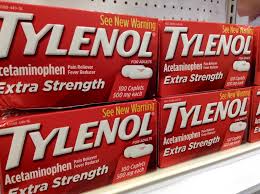Catastrophic Crime: Chicago Tylenol killings

Sitting on the shelf in many drug and grocery stores, boxes of Tylenol seem completely harmless. But in 1982 Chicago, many were laced with cyanide, a deadly poison.
April 6, 2020
What is your first instinct when you have a headache or some soreness and pains? Well, every week, 52 million adults take Tylenol for various reasons. It is a common reaction to dull pain with this over-the-counter medication, used by 23% of adults. However, during January of 1982, this common pain reliever turned deadly.
On the morning of September 29, 1982, Mary Kellerman was the first victim of the Tylenol case. She was twelve years old. Trying to subdue cold symptoms, Kellerman took one Tylenol capsule. Within hours, she was found unconscious and later died in the hospital. That same day, mailman Adam Janus collapsed on his mail route. He was brought to the hospital and died later that day. His brother Stanley Janus and sister-in-law Theresa Janus were later brought to the hospital, both dying within two days.
Doctors were stumped. What was the common correlation that had caused the sudden deaths of four people in such a short amount of time, three of which had been from the same family? All the cases took place in either the city or suburbs of Chicago. None of the victims had any pre-existing conditions that could lead to death, and they were all young and healthy.
As the investigation continued, three more victims were found. The deaths of Paula Prince, Mary McFarland, and Mary Reiner triggered a nationwide fear. The only correlation found between the victims was Tylenol. At each of the victims’ homes, bottles of Tylenol were found, leading detectives into an investigation that proved that each capsule swallowed by the victims had been laced with a lethal dose of cyanide. Investigators determined that the danger was not brought upon by the manufacturer of the product, but from somewhere between manufacture and purchase. The health care giant Johnson & Johnson took a major role in issuing warnings and ordered a mass recall of more than 31 million Tylenol bottles. More tainted bottles were found in grocery stores around Chicago, but fortunately, none had been consumed.
Police were at a standstill after being left with no evidence or suspects when a letter was received by the Tylenol manufacturer. The letter stated that the writer would stop the killings for 1 million dollars. It was traced back to Jame W. Lewis, who claimed to be connected to the events in Chicago. However, he lived in New York, and no evidence was ever found to link him to the Chicago killings. He was arrested and imprisoned for twelve years for extortion. No others were ever suspected, and the killer remains unknown.
Although the killer was never brought to justice, the government responded to the killings by passing the “Tylenol bill” in 1983, making it a federal offense to tamper with consumer goods. Senior Luther Partridge said, “It is sad to see something so useful was also harmful without any of the customers predicting what was coming. Imagine back in the day buying this product just to relieve a minor headache and then hours later you’re in the hospital about to die from a laced product.” In conclusion, while the tragic deaths can never be undone, they increased the safety of consumer goods in our country.











Susan Krause • Apr 6, 2020 at 9:39 pm
That happened my senior year of high school!
I was working at my Dad’s pharmacy at the time and I remember this scare well. Now I am a Pharmacist!
(I am Talley’s Mom.)
Great article.